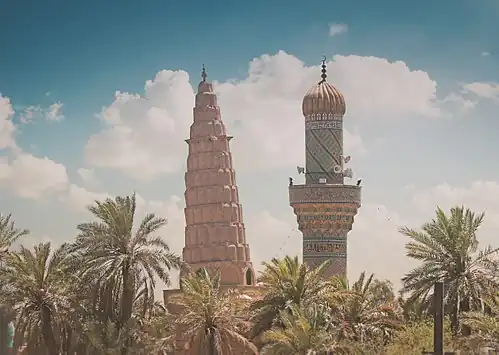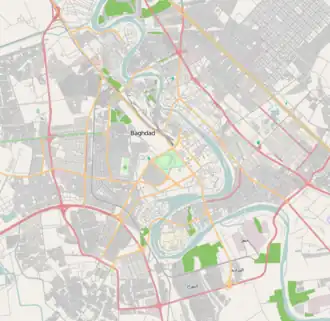Mausoleum of Umar Suhrawardi
| Mausoleum of Umar al-Suhrawardi | |
|---|---|
جامع ومرقد الشيخ عمر السهروردي | |
 The conical dome and minaret in 2017 | |
| Religion | |
| Affiliation | Sunni Islam |
| Ecclesiastical or organisational status | Mosque and mausoleum |
| Status | Active |
| Location | |
| Location | Al-Rusafa, Baghdad, Baghdad Governorate |
| Country | Iraq |
 Location of the mosque in Baghdad | |
| Geographic coordinates | 33°21′2″N 44°24′7″E / 33.35056°N 44.40194°E |
| Architecture | |
| Type | Islamic architecture |
| Style | |
| Founder | al-Nasir li-Din Allah |
| Completed | |
| Specifications | |
| Capacity | 400 worshippers |
| Interior area | 600 m2 (6,500 sq ft) |
| Dome(s) | One: (conical) |
| Minaret(s) | One |
| Shrine(s) | Two: |
| Materials | Marble; bricks |
The Mausoleum of Umar al-Suhrawardi, also known as the Mosque and the Tomb of the Sheikh Umar al-Suhrawardi (Arabic: جامع ومرقد الشيخ عمر السهروردي, romanized: Suhrawardi Mausoleum), is a Sunni mausoleum and mosque complex, located in the southern part of Al-Rusafa, in Baghdad, in the Baghdad Governorate of Iraq. The complex dates from the Abbasid Caliphate and features a unique conical dome built in the Seljuk architectural style. The mosque is situated near the Sheikh Umar Cemetery.
Architecture
The mosque was completed in the 12th-century in the Abbasid style, and the mosque was named after Abu Hafs Umar al-Suhrawardi who was buried in the nearby cemetery. The mosque was renovated by the Ismail Pasha in 1902 and in 1926; and again in 1964 by the Sunni Endowment Office. In 2010, it was reported that the conical tower was in danger of collapse.[1]
The dome was constructed in 735 AH (1334/1335 CE), as indicated by the inscriptions in Thuluth script above the entrance. The dome's design is similar to structures like the Dome of Ezekiel in Babylon. It has ten layers, the lower six consisting of 16 convex niches with rectangular projections, transitioning through octagonal motifs to a ribbed conical cap. The dome and its inscriptions were reportedly renewed by Jamal al-Din Abd al-Rahman ibn Abd al-Mahmud, as inferred from historical texts. Modern renovations focused on structural stability and preservation following the 2003 Iraq War.[2]
The interior features twelve alcoves (three on each wall) with central alcoves adorned by pointed arches supported by plaster columns. Qur'anic inscriptions surround the walls, transitioning to a 16-sided star pattern leading to the hemispherical dome. The square base is approximately 7.5 metres (25 ft) wide and 7.7 metres (25 ft) high. The dome sits atop a drum with intricate muqarnas detailing and is crowned with a ribbed conical structure, tapering into a polygonal peak.[2]
Inscriptions
The main entrance of the mausoleum includes the following inscriptions:
"بسم الله الرحمن الرحيم، ألا إن أولياء الله لا خوف عليهم ولا هم يحزنون. جدد هذه العمارة المباركة (الشريفة) لضريح الشيخ القدوة الرباني قطب الأولياء والعارفين شهاب الدين عمر بن محمد السهروردي، روض الله مرقده محمد بن الرشيد أصلح الله شأنه وذلك في شهور سنة خمس وثلاثون وسبعمائة، والحمد لله وحده وصلواته على نبيه محمد وآله."
The conical dome's inscriptions:
"بسم الله الرحمن الرحيم، فانظر إلى آثار رحمة الله كيف يحيي الله الأرض بعد موتها، إن ذلك لمحيي الموتى وهو على كل شيء قدير. أمر بتجديده بعد دثوره.."
Gallery
-
 The mosque
The mosque -
 The mausoleum in 1924
The mausoleum in 1924
See also
References
- ^ "Mausoleum of Umar Suhrawardi". Advisor.Travel. 2025. Retrieved July 12, 2025.
- ^ a b "Darih al-Suhrawardi". ArchNet.org. n.d. Retrieved July 12, 2025.
External links
![]() Media related to Mausoleum of Umar Suhrawardi at Wikimedia Commons
Media related to Mausoleum of Umar Suhrawardi at Wikimedia Commons